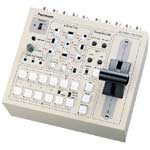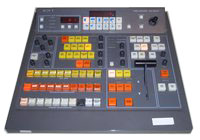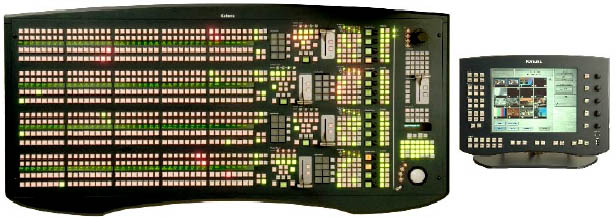Vision Mixer
A vision mixer (AKA video switcher or production switcher) refers to either:
- A device used to mix multiple video sources into one or more master outputs.
- A person who operates a vision mixing device.
Note that the term mixer tends to be European, whereas switcher is a more American term. For the sake of simplicity we will call the mixing device a vision mixer, and the operator a switcher.
Examples

The Panasonic AW-SW350 is a compact half-rack vision mixer with five Y/C and composite video inputs. This would be suitable for a small production studio or field production unit.

The Sony BVS-3200CP is a relatively small desk console suitable for a moderately-sized production unit or OB.
Below: The Snell & Wilcox Kahuna HD/SD console is a monster-sized mixer suitable for large production environments.

What Does a Vision Mixer Do?
The main purpose of a vision mixer is to create a master output for a real-time video recording or broadcast. Typically vision mixers are used for live events, or any event where multiple sources need to be mixed in real-time (as opposed to post-production editing).
Vision mixers can also be used to create various visual effects, from simple mixes and wipes between sources to advanced composite effects.
How Does Vision Mixing Work?
Vision mixers are conceptually similar to audio mixers. They take multiple input sources, apply any desired effects or processing, and provide one or more outputs.
Most vision mixers are based around the preview bus and the program bus, each of which has it's own monitor.
- The program bus is the main output feed, i.e. the vision which is being recorded or broadcast. Whichever source is on the program bus is said to be online.
- The preview bus is used to select and preview the source which is about to be put online.
Note: The preview bus does not have to be used — sources can be cut online without being previewing if desired. However the preview is normally necessary for any visual effects such as transitions, as the effect is constructed from the preview and program sources.
The Role of Vision Switcher
The vision switcher takes their instruction from the director. Basically, the director decides what is going to happen and tells the switcher to do it. A typical set of instructions might go like this:
| Director's Instruction: | Meaning: |
| "1 next" | Preview camera 1 and prepare to put it online. |
| "Take" | Cut camera 1 online. |
| "2 next" | Preview camera 2 and prepare to put it online. |
| "Mix" | Mix camera 2 online. |
| etc etc |
Note: In some studios the director will say "cut" instead of "take". This is a potential source of confusion though, as "cut" is also used to mean "everyone stop".